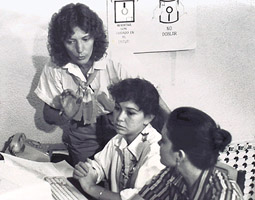TecNica Volunteers worked on projects for many agencies and ministries throughout the country. We have begun with summaries submitted by local TecNica volunteers and those reported in the TecNica literature. If your project is not listed here, tell us about it in the comments section below and we will add it. Please consider doing a longer Volunteer Profile as your own page!
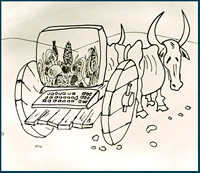 Brief Examples of Volunteers’ Projects
Brief Examples of Volunteers’ Projects
Henry Alquist, Mechanical Engineer
From St. Simons Island, Georgia, Henry was a retired mechanical engineer specializing in fuel and alternative energy. He worked at the Ministry of Health diagnosing and working on problems with the steam boilers at hospitals in Masaya, Matagalpa, and Managua. He worked at these hospitals with the single Nicaraguan responsible for all of this equipment throughout the country, who had only limited operational and repair training. In this period steps were taken toward establishing a preventive maintenance program and changing numerous incorrect operating procedures which would have resulted in more serious breakdowns. Henry prepared an extensive list of badly needed manuals, valves, filters, lubrication oil, and other parts.
John Brinkmann, Machinist
John Brinkmann trained Nicaraguan machinists in the use of machine tools.
Nancy Emerick, Environmental Health Specialist
Nancy worked at the water treatment plant in Matagalpa in September 1987. She inspected the rapid sand filters, which hadn’t been replaced since 1979! She also taught the plant staff how to use a field lab to evaluate water, established standards for settling agent additives, and brought much-needed equipment, chemicals, a lab kit, and Spanish language documentation.
Glenn Davis, Renovation Contractor
Glen worked at the Milca Bottling Plant identifying potential project needs. During his stay, Glenn visited more than twenty project sites in Nicaragua, and then helped to recruit Canadian volunteers to meet specific needs requested by the Nicaraguans. Since 1987, more than 30 Canadian TecNica Volunteers have worked in Nicaragua.
INIES is an independent Research Institute in Managua that analyzes economic and social data of the Central American region—books, articles, governmental statistical data, conference proceedings, theses, clipping files, and newspapers. The problem presented to TecNica in 1985 was that, although each item in the collection was listed by title, its contents by subject were not. Principal researchers spent a great deal of time gathering data from the collection, cutting into critically important analytical and writing time. Mary came from the University of California Library Automation Project where she had worked for 6 years, and secured the donation of an information retrieval computer program that enabled analytic cataloging for INIES’ computer. During her first trip, Mary helped INIES staff evaluate the program, installed it, and taught the library staff how to use it. Mary returned for several more trips to further this project and initiate others at the National Library in Managua and the Center for Documentation on the Atlantic Coast (CIDCA).
Glen Farley, Database Specialist
Canadian Glen Farley spent three weeks in November 1986 working on two dBase III projects at the School of Mathematics, Statistics, and Computer Science at the National Autonomous University of Nicaragua (UNAN). Following up on a previous TecNica placement, he worked on the database system for the student records at the university. Glen improved the system, added new maintenance features, and trained the head of the school, two professors and two clerical staff in its use. In addition, he conducted an Introductory dBASE III Workshop for the staff to provide a basic working knowledge of the system. Glen also participated in the preliminary planning of the CAIS project, one of TecNica’s major priorities in 1987.
Ken Fishkin, Computer Graphics Expert
 A Ph.D. candidate at the University of California, Berkeley, in Computer Science, Ken specialized in graphical paint programs. At the Nicaraguan Ministerio de Educación Ken taught current staff how to use the existing payroll database program to generate teachers’ paychecks, and went to work fixing bugs in the “Manager” program. After returning to the United States, Ken went on to work at Pixar and Xerox Parc Research Center.
A Ph.D. candidate at the University of California, Berkeley, in Computer Science, Ken specialized in graphical paint programs. At the Nicaraguan Ministerio de Educación Ken taught current staff how to use the existing payroll database program to generate teachers’ paychecks, and went to work fixing bugs in the “Manager” program. After returning to the United States, Ken went on to work at Pixar and Xerox Parc Research Center.
Stephen Heffernam, Computer Training Specialist
An important priority for TecNica in 1987 was assistance in CAIS (Centro Adiestramiento Informatico y Systemas), Nicaragua’s national microcomputer training center. In his two week placement, Steve consulted with the center’s staff on course design, adult learning, and training methods, as well as actually training them in the use of three types of software (dBASE III, Lotus 1-2-3, and Word Perfect). In addition, Steve spoke at a conference of the Association of Computer Professionals on their role in guiding the development of microcomputer use in Nicaragua. Steve followed up at home by helping to recruit and orient volunteers for the CAIS, continuing to advise the Center as it grew, organizing public education events, and raising funds for material aid to the Center.
Bernie Hovden, Electronics and Computer Hardware Repair
At the Ministerio de Salud (MINSA, the Health Department), Bernie conducted a survey of electronic gear in MINSA offices and clinics in Nicaragua to identify weaknesses in employees’ understanding of computer and electronic systems, with the objective of offering training where it was needed.
John Kellogg, Machinist
John Kellogg worked with a Nicaragua Energy Institute technician on an oil dielectric tester.
John Leek, Machinist
John Leek taught machine shop at Boston University and was placed at the Nicaraguan Ministry of Energy (INE). He began working in their Managua maintenance shop machining a part needed by a small hydroelectric facility damaged in a “contra” attack some months earlier. This small plant supplied electrical power to El Cuá, a small agricultural village not far from the Honduran border. John spent several days in the village installing the part and putting the system back on line.
Ann Lopez, Biologist
An international biologist who taught at San Jose City College in California, Ann worked at the Biology Department of the University of Central America (UCA) and at Nicaragua’s National Herbarium. She specialized in botany and ecology, and thereby advised biology teachers on how to improve their courses. She worked with Alfredo Grifalva, the Director of the National Herbarium. Nicaragua’s ability to rescue, analyze, and utilize its medicinal plants will play an important part in the country’s expanding health care system. “The more I studied the unique ecology of Nicaragua and learned about the potential medicinal value of many of the plants, I became increasingly amazed that the world scientific community has not discovered the biological richness and uniqueness of this country.”
Mary Jo Marino, Electrician
An industrial electrician from York City, Mary Jo worked in Managua repairing city vehicles. She lent her skills to two understaffed shops, each of which had only one skilled electrician.
Bernie McFall, Computer Programmer
Bernie McFall worked as a volunteer consultant on IBM mainframes in Managua. He taught structured COBOL computer programming to students at the Ministry of Finance.
William McKane, Machinist
Bill McKane, then a 65-year old machinist from New York, went to Nicaragua in July, 1988, to work for COMPANIC, a major state-owned printing enterprise which published books for Nicaragua’s literacy campaign. When the government of Czechoslovakia donated a new lathe to COMPANIC’s maintenance department, the Nicaraguans found that no one knew how to operate it. Bill trained a COMPANIC worker to use the machine. By the time Bill completed his two-week assignment, his student had repaired the shaft on an electrical motor and built a vacuum mechanism for a broken printing press. At Bill’s recommendation, another TecNica Volunteer working in Nicaragua for six months was assigned to COMPANIC one day a week. The U.S. trade embargo had made spare parts extremely hard to obtain—but thanks to Bill McKane and other skilled trades workers, Nicaragua’s presses kept rolling!
Marilyn McMahon, Writer and Software Specialist
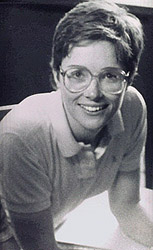 The Sandinista Cultural Workers Association (ASTC) kept information like artists’ resumes in a personal computer database, which an intrepid librarian was using and programming, having learned on her own without any documentation in Spanish. Marilyn, having written a book about the system (dBASE II), was able to answer her questions and instruct her in advanced techniques. Marilyn will never forget this bright, determined woman who rode buses two hours each way every day to work at ASTC.
The Sandinista Cultural Workers Association (ASTC) kept information like artists’ resumes in a personal computer database, which an intrepid librarian was using and programming, having learned on her own without any documentation in Spanish. Marilyn, having written a book about the system (dBASE II), was able to answer her questions and instruct her in advanced techniques. Marilyn will never forget this bright, determined woman who rode buses two hours each way every day to work at ASTC.
On her second Nicaragua stint, Marilyn worked at CISAS, an NGO providing health education and informational materials. The staff all wanted training on standard office software—word processing, spreadsheet, and database. Marilyn tutored them individually, teaching them how to use the software to maintain their materials inventory, write documents such as lesson plans, theatrical scripts, and conference speeches, and write budgets. This wonderful organization, staffed entirely by women, traveled into the war zones to teach villagers about health and hygiene, saving lives with this educational work. One of Marilyn’s fond memories of her CISAS work was when Ben Linder—a close friend of CISAS’s director—visited for lunch and a lively creative discussion ensued about educating through puppet shows.
Terry Mitchell, Clinical Audiologist
In August of 1987, Terry volunteered at the Melania Morales Center for Special Education in Managua. Of the 150 hearing-impaired children at this school, less than 10 had hearing aids, of which only two actually functioned. In the mornings, Terry worked with the students, testing their hearing and working with the children’s hearing aids. In the afternoons she taught a four-hour intensive class for teachers of the deaf on hearing aids, auditory training, and special education strategies. Part of the class included hands-on training in the use of calibrated noisemakers for auditory training and evaluation, the use of otoscopes for checking earwax and training in how to make accurate ear mold impressions from which to make ear molds. Terry initiated an ongoing project called “Help Kids Communicate” to recruit and place volunteers at the school and raise funds for material support.
Victoria Meyers, Health Services Administrator
Vicki Meyers is experienced in health education, program planning, and financial and personnel management for health service organizations. She managed a hospital clinic in San Jose, California. As a TecNica Volunteer, Vicki designed an audiovisual program to educate medical students and mothers about infant diarrhea—the leading cause of death among Nicaraguan children under five years old. She trained third- and fourth-year medical students at the Pedro Altamirano Health Center and advised administrators at three Nicaraguan hospitals on the design of prevention education materials for the local population. Vicki’s audiovisual program was used in hospitals and clinics throughout the country as part of the Ministry of Health’s campaign to eradicate infant diarrhea and save the lives of Nicaragua’s children.
Greg Nelson, Machinist
In 1989, Mike Hebert and Greg Nelson participated in two TecNica projects. The first was the delivery of a FedEx van for the Hospital Generator project. “Dave Wald recruited us to drive from San Jose to Managua and deliver the vehicle to Van Assayan (sp). Once we finished that we went to work for El Nuevo Diario with John Sarge, who flew in from New York. We rebuilt the gearbox on a Goss Community press for El Nuevo Diario and then worked for a week at Barricada. We flew back to San Jose after two weeks in Managua. We were honored to be a part of these projects.”
Brian O’Hanlon, Computer Programmer
Brian wrote computer programs that automated the summation of solar radiation charts for the Nicaraguan Ministry INETER. [Who knows more about this? Comments?]
Werner Rust, Chemical Engineer
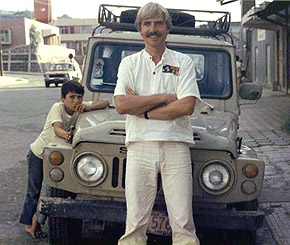 From Menlo Park, CA, Werner is a chemical engineer with 19 years experience in private industry and university research. He spent two weeks working at Las Maderas Grain Storage and Drying Cooperative in a rich agricultural valley north of Managua. The cooperative was trying to conserve fuel by preheating air before it entered the dryer’s furnace, thereby enabling it to be operated at a lower temperature and use less fuel. An earlier team from Sweden had designed and helped build a funnel of wood and transparent plastic. However, the plastic sheeting, made in Managua, was not resistant to the sun’s ultra-violet rays, which caused the plastic to deteriorate rapidly. An improved plastic was available from Sweden, but was much too expensive to purchase. Werner carefully determined the specifications of the Swedish material and worked with a private Nicaraguan plastic manufacturer to reproduce the more resistant plastic locally, at a cost the cooperative could afford.
From Menlo Park, CA, Werner is a chemical engineer with 19 years experience in private industry and university research. He spent two weeks working at Las Maderas Grain Storage and Drying Cooperative in a rich agricultural valley north of Managua. The cooperative was trying to conserve fuel by preheating air before it entered the dryer’s furnace, thereby enabling it to be operated at a lower temperature and use less fuel. An earlier team from Sweden had designed and helped build a funnel of wood and transparent plastic. However, the plastic sheeting, made in Managua, was not resistant to the sun’s ultra-violet rays, which caused the plastic to deteriorate rapidly. An improved plastic was available from Sweden, but was much too expensive to purchase. Werner carefully determined the specifications of the Swedish material and worked with a private Nicaraguan plastic manufacturer to reproduce the more resistant plastic locally, at a cost the cooperative could afford.
Marsha Silver, Speech and Language Pathologist
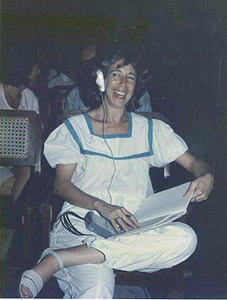 In 1987, the Ministry of Education created a program to train select teachers to become speech and language pathologists (SLPs). At that time, there were only two SLPs in the country to treat all the children with communication disorders. Marsha wrote a curriculum that mapped out a one-year crash course of study in the diagnosis and management of speech and language disorders. She met with the speech pathologists who were planning to implement the program with the help of visiting SLPs from Cuba who would serve as the teachers. Marsha visited the special education centers and several ear, nose and throat specialists who treated children with physical abnormalities such as cleft palate or voice disorders. She visited children in the schools to better understand how to deliver services to them. It was a full and demanding two weeks that will never be forgotten.
In 1987, the Ministry of Education created a program to train select teachers to become speech and language pathologists (SLPs). At that time, there were only two SLPs in the country to treat all the children with communication disorders. Marsha wrote a curriculum that mapped out a one-year crash course of study in the diagnosis and management of speech and language disorders. She met with the speech pathologists who were planning to implement the program with the help of visiting SLPs from Cuba who would serve as the teachers. Marsha visited the special education centers and several ear, nose and throat specialists who treated children with physical abnormalities such as cleft palate or voice disorders. She visited children in the schools to better understand how to deliver services to them. It was a full and demanding two weeks that will never be forgotten.
Tom Stone, Software Design
Tom Stone taught structured programming to Nicaraguan programmers.
Peter Wood, Computer Hardware Systems Planner
Peter Wood worked at the University of Central America (UCA), a Jesuit institution that was that received 80% of its support from the government). Peter’s task was to purchase and install a new, upgraded computer system for the UCA.
Jane Stein, Systems Analyst
Jane Stein managed the computer section of the Health Services Research Center for the University of North Carolina at Chapel Hill. With more than 15 years of experience in systems analysis, operations research, and project management using IBM mainframe and Apple microcomputer systems, Jane advised senior administrative officers on the design of a computer-based information system for Nicaragua’s Supreme Court. By examining the information systems and operations of the Supreme Court and recommending measures to correct administrative problems, Jane helped the Nicaraguan government better maintain an independent judiciary and guarantee the civil rights of its citizens.
Save

